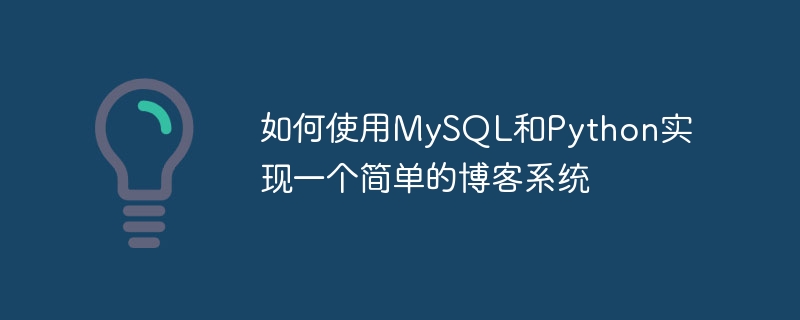Home >Database >Mysql Tutorial >How to implement a simple blog system using MySQL and Python
How to implement a simple blog system using MySQL and Python
- 王林Original
- 2023-09-21 13:00:18759browse

How to use MySQL and Python to implement a simple blog system
In this article, we will use MySQL and Python to create a simple blog system. We will use MySQL to store the blog's data, including the blog's title, content, author, and publication date. We will use Python as the backend language to handle interaction with the database and provide a simple user interface to manage and display the blog.
First, we need to install the related dependency libraries of MySQL and Python. You can install them using the following command:
pip install mysql-connector-python
Next, we will create a database named "blog", and a table named "posts" to store the blog's data. You can create them using the following code:
import mysql.connector
# 连接MySQL数据库
mydb = mysql.connector.connect(
host="localhost",
user="yourusername",
password="yourpassword"
)
# 创建数据库
mycursor = mydb.cursor()
mycursor.execute("CREATE DATABASE blog")
# 使用数据库
mycursor.execute("USE blog")
# 创建博客表格
mycursor.execute("CREATE TABLE posts (id INT AUTO_INCREMENT PRIMARY KEY, title VARCHAR(255), content TEXT, author VARCHAR(255), publish_date DATE)")Now, we are ready to start writing Python code. We will create a simple Blog class that contains several methods for managing the blog's data.
import mysql.connector
class Blog:
def __init__(self, host, user, password, database):
# 连接MySQL数据库
self.mydb = mysql.connector.connect(
host=host,
user=user,
password=password,
database=database
)
# 创建游标对象
self.mycursor = self.mydb.cursor()
def create_post(self, title, content, author, publish_date):
# 插入博客数据到数据库
sql = "INSERT INTO posts (title, content, author, publish_date) VALUES (%s, %s, %s, %s)"
val = (title, content, author, publish_date)
self.mycursor.execute(sql, val)
# 提交事务
self.mydb.commit()
def get_all_posts(self):
# 查询所有博客数据
self.mycursor.execute("SELECT * FROM posts")
result = self.mycursor.fetchall()
# 返回查询结果
return result
def get_post_by_id(self, post_id):
# 根据博客ID查询数据
self.mycursor.execute("SELECT * FROM posts WHERE id = %s", (post_id,))
result = self.mycursor.fetchone()
# 返回查询结果
return result
def update_post(self, post_id, title, content, author, publish_date):
# 更新博客数据
sql = "UPDATE posts SET title = %s, content = %s, author = %s, publish_date = %s WHERE id = %s"
val = (title, content, author, publish_date, post_id)
self.mycursor.execute(sql, val)
# 提交事务
self.mydb.commit()
def delete_post(self, post_id):
# 删除博客数据
self.mycursor.execute("DELETE FROM posts WHERE id = %s", (post_id,))
# 提交事务
self.mydb.commit()Now, we can use this blog class to manage the blog. The following is a simple example:
blog = Blog("localhost", "yourusername", "yourpassword", "blog")
# 创建博客
blog.create_post("第一篇博客", "这是我的第一篇博客内容", "作者A", "2021-01-01")
# 获取所有博客
posts = blog.get_all_posts()
for post in posts:
print(post)
# 获取指定ID的博客
post = blog.get_post_by_id(1)
print(post)
# 更新博客
blog.update_post(1, "更新后的博客标题", "更新后的博客内容", "作者B", "2021-02-01")
# 删除博客
blog.delete_post(1)The above code is only an example, you can modify and extend it according to your own needs. For example, you can add more fields to store information such as blog tags and pageviews. You can also add user authentication and rights management functions to enhance the security of your blog system.
I hope this article can help you understand how to use MySQL and Python to implement a simple blog system. If you have any questions, please leave them in the comment area and I will try my best to answer them.
The above is the detailed content of How to implement a simple blog system using MySQL and Python. For more information, please follow other related articles on the PHP Chinese website!

